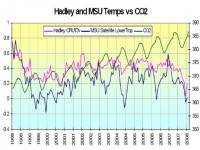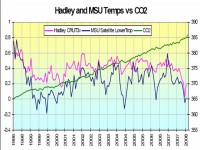By Joseph D’Aleo, CCM
This is the latest decadal plot from February 1998 to February 2008 of global temperatures from Satellite (UAH MSU lower troposphere) (blue) and land and ocean variance adjusted surface (Hadley CRU T3v) (rose) plotted with Scripps monthly CO2 from Mauna Loa (green).

See larger graph here.
The decadal correlation strengths (r-squared) of both the Hadley and MSU satellite with the corresponding CO2 is non-existent (r2=0.00). If you start in 2000 at the coldest point of the last decade, this does not significantly change (r2=0.01 for the Hadley and r2=0.08 for MSU). These numbers also do not change if you use the Scripps seasonally adjusted CO2 values (r2=0.00 for both the decadal Hadley and MSU). The correlation since 2000 stays at r2=0.01 for the Hadley but drops to r2=0.05 for the MSU using this seasonally adjusted CO2.

See larger graph here.
The challenge of course will be that a decade (or 7 years) is not a fair test, longer term monitoring is required to determine real trends. My response is that we are being told by Al Gore and James Hansen that the problem is worse than the IPCC and the scientists feared. That we are rapidly nearing the tipping point and that unless we take painful action immediately, temperatures will run away from us. If that was the case we should see some correlation even in the short term. It doesn’t take an advanced science degree to see there has been virtually no trend in the temperature data in the last decade or this century even as CO2 has increased 5.5%. Even the IPCC head Dr. Rajendra Pachauri has noticed the disconnect and acknowledged we have to look and see if natural forces were somehow countering greenhouse warming.
See in the attached pdf though how the temperatures do correspond far better with the ENSO cycles and longer term with PDO which controls the relative frequency of El Nino and La Nina. With an apparent shift on the regime of the PDO to cool and the prospects of solar cycles 24 and 25 being quiet, global cooling is more likely than global warming in the decades ahead.
See here in this Energy and Environment paper how this so called correlation comes and goes with the natural cycles.




